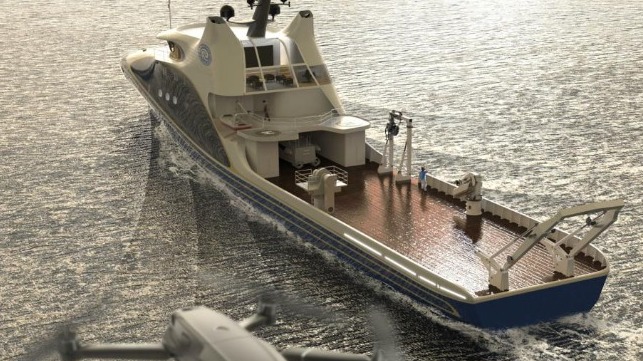CSSC Lays Keel for Drone-Carrying Autonomous Research Vessel

A Chinese research institute has commissioned what may well be the first autonomous oceangoing research vessel with the capability of launching its own drones, and construction is now underway
The Southern Marine Science and Engineering Guangdong Laboratory (Zhuhai) ordered the novel ship from CSSC's Huangpu Wenchong Shipyard in December. The vessel's dimensions are substantial, at 290 feet in length and about 2,000 dwt - nearly the size of a typical U.S. Navy-owned manned research vessel. Its capacious back deck is designed to carry "dozens" of unmanned systems for autonomous deployment in batches, and it has twin A-frames for over-the-side operations.
The ship will be equipped for autonomous navigation, with human pilots to take her in and out of port. The objective is to send it on marine survey missions without personnel on board. It will be equipped with unmanned systems and drones that it can launch and recover on its own. All of its core technology is Chinese, according to the builder.
"The power system, propulsion system, intelligent system, and survey operation support system it carries are all made in China, and the core technology can be independently controlled,” said Fan Lei, chief architect of CSSC Huangpu Wenchong.
The operational objective is to use the ship's drones in a coordinated formation to examine a three-dimensional target - a system that the Southern Ocean Laboratory has named "Intelligent Fast Mobile Ocean Stereo Observation System (IMOSOS)."
"This mothership itself has more than 50 unmanned systems mounted on it, including our unmanned aerial vehicles . . . as well as the unmanned surface vehicles, there are diesel-powered, wave-powered and solar-powered ones. For underwater, there are smart profile buoys, which can make observations from surface to underwater, and also the underwater [glider]," explained Dr. Zhang Yunfei, founder and president of Zhuhai Yunzhou Intelligence Technology and the force behind the IMOSOS concept. "The system spans about 100 kilometers in diameter, four kilometers into the air, and four kilometers into the water surface, covering a 3D area in the sea, to make a large-scale, comprehensive and simultaneous observation from multiple nodes."
The capabilities provided by a drone-enabled sensor mesh could have possible crossover applications for anti-submarine warfare and C4ISR in the China Southern Ocean Laboratory's primary area of operation, the South China Sea.
